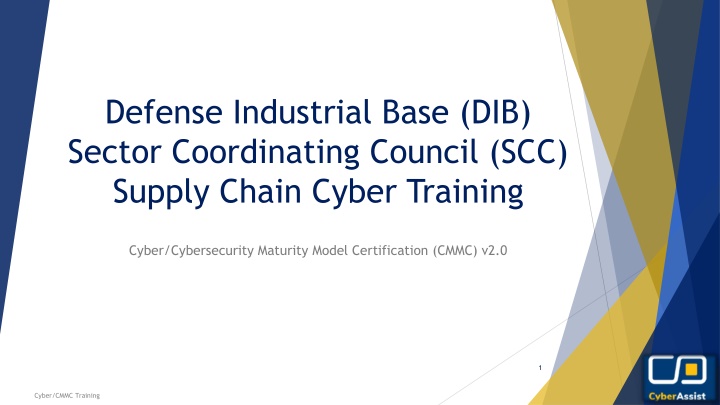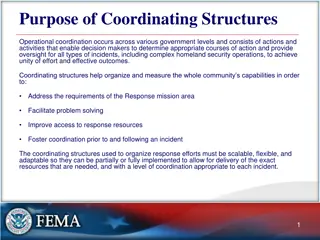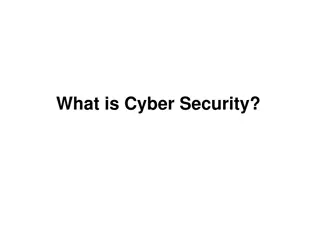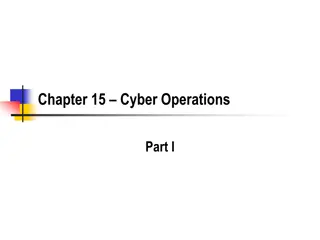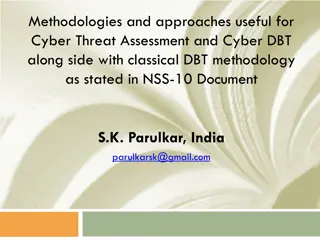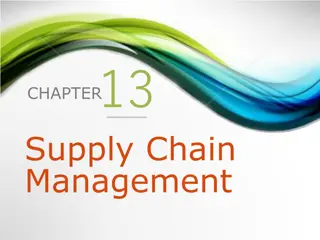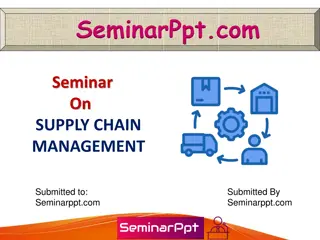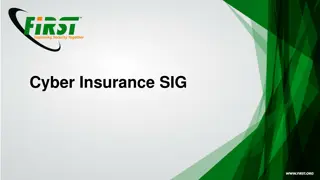DIB Sector Coordinating Council SCC Supply Chain Cyber Training
The Defense Industrial Base (DIB) Sector Coordinating Council (SCC) offers training in Supply Chain Cybersecurity Maturity Model Certification (CMMC) v2.01. This training program focuses on enhancing cybersecurity capabilities within the defense industry supply chain to ensure maturity in securing sensitive data and systems. By participating in this program, organizations can strengthen their cyber defenses and meet the necessary requirements for certification.
Download Presentation

Please find below an Image/Link to download the presentation.
The content on the website is provided AS IS for your information and personal use only. It may not be sold, licensed, or shared on other websites without obtaining consent from the author.If you encounter any issues during the download, it is possible that the publisher has removed the file from their server.
You are allowed to download the files provided on this website for personal or commercial use, subject to the condition that they are used lawfully. All files are the property of their respective owners.
The content on the website is provided AS IS for your information and personal use only. It may not be sold, licensed, or shared on other websites without obtaining consent from the author.
E N D
Presentation Transcript
Defense Industrial Base (DIB) Sector Coordinating Council (SCC) Supply Chain Cyber Training Cyber/Cybersecurity Maturity Model Certification (CMMC) v2.0 1 Cyber/CMMC Training
Agenda Module 1: Cybersecurity: Why it is Important? Module 2: Cybersecurity Maturity Model Certification Module 3: Assessment Process - Interim Module 4: Incident Reporting Module 5: Cybersecurity Best Practices Module 6: Risk Management and Assessing Risk Resource Guide: Glossary, Acronym Guide and Resources for Additional Information CMMC Domains Survey 2 Cyber/CMMC Training
Risk Management and Assessing Risk Module 6 3 Cyber/CMMC Training
Note: CMMC is still going through the rule- making process and certain aspects and requirements may change. Refer to the Resources Guide provided in this training for the most updated information. Disclaimer and Overview The intent of this training is to build awareness for Defense Industrial Base (DIB) suppliers of the likely requirements of the Cybersecurity Maturity Model Certification (CMMC) and their obligation to meet FAR 52.204-21 (basic cyber hygiene) and DFARS 252.204-7012 (specialized data handling and protection requirements). This training is self-paced and intended for a range of roles and responsibilities including, but not limited to, executives, project managers and technical staff from organizations seeking certification (OSC) and need to comply with CMMC. Currently, CMMC does not apply to any contractor. Note: Completion of this training DOES NOT certify your organization. This training is intended for the purposes of providing awareness of the subjects outlined above. The DIB Sector Coordinating Council (SCC) Supply Chain Task Force does not take responsibility for suppliers certification by the CMMC 3rd Party Assessment Organization (C3PAO). This training focuses on U.S. regulations and industry best practices: U.S. Department of Defense (DoD) Chief Information Officer (CIO) Cybersecurity Maturity Model Certification (CMMC) Information National Institute of Standards & Technologies (NIST) publications National Archives & Records Administration (NARA) definitions DIB SCC Supply Chain Task Force CyberAssist website 4 Cyber/CMMC Training
Module Topics and Objectives Helpful Hint: Refer to the Resource Guide for a Glossary and Acronym Guide Topics covered in this module: Risk Management 101 Risk Identification Risk Evaluation and Measurement Risk Control Management and Implementation Risk Management Key Points The objectives of this module are: Provide understanding of risk management; Provide understanding of risk identification; and Provide understanding of risk control management and implementation. A legend has been provided to assist with determining the content that you will need to know for each of the CMMC levels and what is additional content that will assist your organization with your cybersecurity posture. The corresponding symbol will be located at the top left corner of the slide. Content Legend = CMMC L1 Content = CMMC L2 Content = CMMC L3 Content = Non-CMMC Content/Extra Cyber/CMMC Training 5
Risk Management 101 Risk management applies to many aspects of a business. Internal risks (weaknesses) - controllable External risks (threats) typically uncontrollable Negative (weaknesses and threats) Positive (opportunities) The ultimate goal is to minimize the effects of risks on your business. Business continuity Greater stability Better cash flow Longevity Stages of Risk Management Risk Identification Internal vs. External Risks Risk Evaluation Risk Measurement Risk Control Management and Implementation 6 Cyber/CMMC Training
Risk Identification Internal Risks Employee Risks External Risks Competition and Market Risks Illness and death Market changes Theft and fraud Loss of employees Low employee morale Rent increase Personal conflicts Business Environment Risks Complacency Laws and ordinances (federal, state, local) Insider threat Equipment and Information Technology Risks Weather and natural disasters Community changes Old equipment Visibility Patching Non-Employee Risks Cybersecurity Other Unprovoked violence Theft of goods and services Other technologies such as phones Malicious Cyber Threat Actor Injuries and damage to business Cash flow Visibility 7 Cyber/CMMC Training
Risk Evaluation and Measurement Evaluate SWOT (Strengths, Weaknesses, Opportunities, Threats) Identify Warning Signs Excessive debt to equity ratio Reliance on small number of customers, products, vendors Cash flow issues Irregularities in records (timekeeping, accounting, bank) Irregularities in reports (computers, users) High turnover rate Risk Measurement Likelihood vs impact 8 Cyber/CMMC Training
Risk Control Management and Implementation Equipment Vendors Business Continuity IT Systems Competition Accounting and Cash Flow Employee Management Business Work Strategy Exit Strategy 9 Cyber/CMMC Training
Risk Management Key Points Risks associated with a small business, or any business, can be characterized as internal or external. 1. Begin assessing risks by listing events or resources that could impact continued operations and cash flow. 2. The costs to insure or minimize risks should be weighed against the potential impact of the risk. 3. A business continuity plan should be part of your overall business plan. 4. Strategies to avoid risks can include: communication, setting expectations, support systems, staff training, insurance, risk assessment, and contingency planning. 5. Be honest in reviewing your business for risk and know the warning signs. 6. Seek assistance from others. 7. Include an exit strategy in your initial business plan and revisit that strategy from time to time. 8. Note: For more information on risk management, there is a free NIST training course (approximately three hours): Risk Management Framework for Systems and Organizations Introductory Course 10 Cyber/CMMC Training
Module Summary Ultimate goal on Risk Management: To control the effects of risks on your business There are four stages for Risk Management: Risk Identification Risk Evaluation Risk Measurement Risk Control Management and Implementation Risks associated with business can be characterized as internal or external 11 Cyber/CMMC Training
